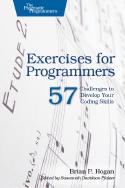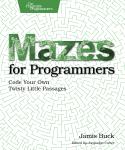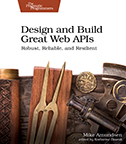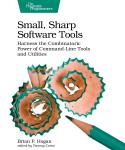About This Title
Pages: 506
Published: August 2020
ISBN: 9781680507225
In Print

A Common-Sense Guide to Data Structures and Algorithms, Second Edition
Level Up Your Core Programming Skills
by Jay Wengrow
If you thought that data structures and algorithms were all just theory, you’re missing out on what they can do for your code. Learn to use Big O notation to make your code run faster by orders of magnitude. Choose from data structures such as hash tables, trees, and graphs to increase your code’s efficiency exponentially. With simple language and clear diagrams, this book makes this complex topic accessible, no matter your background. This new edition features practice exercises in every chapter, and new chapters on topics such as dynamic programming and heaps and tries. Get the hands-on info you need to master data structures and algorithms for your day-to-day work.
eBook Formats:
PDF for desktop/tablets
epub for Apple Books, e-readers
mobi for Kindle readers
Get all eBook formats here for $29.95 (USD)
Paperback Formats:
Order via Bookshop (U.S. Only)
Please support indie bookstores!
Find indie bookstores in the U.S. Find indie bookstores around the world.
Algorithms and data structures are much more than abstract concepts. Mastering them enables you to write code that runs faster and more efficiently, which is particularly important for today’s web and mobile apps. Take a practical approach to data structures and algorithms, with techniques and real-world scenarios that you can use in your daily production code, with examples in JavaScript, Python, and Ruby. This new and revised second edition features new chapters on recursion, dynamic programming, and using Big O in your daily work.
Use Big O notation to measure and articulate the efficiency of your code, and modify your algorithm to make it faster. Find out how your choice of arrays, linked lists, and hash tables can dramatically affect the code you write. Use recursion to solve tricky problems and create algorithms that run exponentially faster than the alternatives. Dig into advanced data structures such as binary trees and graphs to help scale specialized applications such as social networks and mapping software. You’ll even encounter a single keyword that can give your code a turbo boost. Practice your new skills with exercises in every chapter, along with detailed solutions.
Use these techniques today to make your code faster and more scalable.
What You Need
No requirementsResources
Releases:
Contents & Extracts
- Preface
- Who Is This Book For?
- What’s New in the Second Edition
- What’s in This Book?
- How to Read This Book
- Code Examples
- Online Resources
- Acknowledgments
- Connecting
- Why Data Structures Matter
excerpt

- Data Structures
- The Array: The Foundational Data Structure
- Measuring Speed
- Reading
- Searching
- Insertion
- Deletion
- Sets: How a Single Rule Can Affect Efficiency
- Wrapping Up
- Exercises
- Why Algorithms Matter
- Ordered Arrays
- Searching an Ordered Array
- Binary Search
- Binary Search vs. Linear Search
- Wrapping Up
- Exercises
- O Yes! Big O Notation
- Big O: How Many Steps Relative to N Elements?
- The Soul of Big O
- An Algorithm of the Third Kind
- Logarithms
- O (log N) Explained
- Practical Examples
- Wrapping Up
- Exercises
- Speeding Up Your Code with Big O
- Bubble Sort
excerpt

- Bubble Sort in Action
- The Efficiency of Bubble Sort
- A Quadratic Problem
- A Linear Solution
- Wrapping Up
- Exercises
- Bubble Sort
excerpt
- Optimizing Code with and Without Big O
- Selection Sort
- Selection Sort in Action
- The Efficiency of Selection Sort
- Ignoring Constants
- Big O Categories
- Wrapping Up
- Exercises
- Optimizing for Optimistic Scenarios
- Insertion Sort
- Insertion Sort in Action
- The Efficiency of Insertion Sort
- The Average Case
- A Practical Example
- Wrapping Up
- Exercises
- Big O in Everyday Code
excerpt

- Mean Average of Even Numbers
- Word Builder
- Array Sample
- Average Celsius Reading
- Clothing Labels
- Count the Ones
- Palindrome Checker
- Get All the Products
- Password Cracker
- Wrapping Up
- Exercises
- Blazing Fast Lookup with Hash Tables
- Hash Tables
- Hashing with Hash Functions
- Building a Thesaurus for Fun and Profit, but Mainly Profit
- Hash Table Lookups
- Dealing with Collisions
- Making an Efficient Hash Table
- Hash Tables for Organization
- Hash Tables for Speed
- Wrapping Up
- Exercises
- Crafting Elegant Code with Stacks and Queues
- Stacks
- Abstract Data Types
- Stacks in Action
- The Importance of Constrained Data Structures
- Queues
- Queues in Action
- Wrapping Up
- Exercises
- Recursively Recurse with Recursion
- Recurse Instead of Loop
- The Base Case
- Reading Recursive Code
- Recursion in the Eyes of the Computer
- Filesystem Traversal
- Wrapping Up
- Exercises
- Learning to Write in Recursive
- Recursive Category: Repeatedly Execute
- Recursive Category: Calculations
- Top-Down Recursion: A New Way of Thinking
- The Staircase Problem
- Anagram Generation
- Wrapping Up
- Exercises
- Dynamic Programming
- Unnecessary Recursive Calls
- The Little Fix for Big O
- The Efficiency of Recursion
- Overlapping Subproblems
- Dynamic Programming through Memoization
- Dynamic Programming through Going Bottom-Up
- Wrapping Up
- Exercises
- Recursive Algorithms for Speed
- Partitioning
- Quicksort
- The Efficiency of Quicksort
- Quicksort in the Worst-Case Scenario
- Quickselect
- Sorting as a Key to Other Algorithms
- Wrapping Up
- Exercises
- Node-Based Data Structures
- Linked Lists
- Implementing a Linked List
- Reading
- Searching
- Insertion
- Deletion
- Efficiency of Linked List Operations
- Linked Lists in Action
- Doubly Linked Lists
- Queues as Doubly Linked Lists
- Wrapping Up
- Exercises
- Speeding Up All the Things with Binary Search Trees
- Trees
- Binary Search Trees
- Searching
- Insertion
- Deletion
- Binary Search Trees in Action
- Binary Search Tree Traversal
- Wrapping Up
- Exercises
- Keeping Your Priorities Straight with Heaps
- Priority Queues
- Heaps
- Heap Properties
- Heap Insertion
- Looking for the Last Node
- Heap Deletion
- Heaps vs. Ordered Arrays
- The Problem of the Last Node…Again
- Arrays as Heaps
- Heaps as Priority Queues
- Wrapping Up
- Exercises
- It Doesn’t Hurt to Trie
- Tries
- Storing Words
- Trie Search
- The Efficiency of Trie Search
- Trie Insertion
- Building Autocomplete
- Completing Autocomplete
- Tries with Values: A Better Autocomplete
- Wrapping Up
- Exercises
- Connecting Everything with Graphs
- Graphs
- Directed Graphs
- Object-Oriented Graph Implementation
- Graph Search
- Depth-First Search
- Breadth-First Search
- The Efficiency of Graph Search
- Weighted Graphs
- Dijkstra’s Algorithm
- Wrapping Up
- Exercises
- Dealing with Space Constraints
- Big O of Space Complexity
- Trade-Offs Between Time and Space
- The Hidden Cost of Recursion
- Wrapping Up
- Exercises
- Techniques for Code Optimization
- Prerequisite: Determine Your Current Big O
- Start Here: The Best-Imaginable Big O
- Magical Lookups
- Recognizing Patterns
- Greedy Algorithms
- Change the Data Structure
- Wrapping Up
- Parting Thoughts
- Exercises
- Exercise Solutions
- Chapter 1
- Chapter 2
- Chapter 3
- Chapter 4
- Chapter 5
- Chapter 6
- Chapter 7
- Chapter 8
- Chapter 9
- Chapter 10
- Chapter 11
- Chapter 12
- Chapter 13
- Chapter 14
- Chapter 15
- Chapter 16
- Chapter 17
- Chapter 18
- Chapter 19
- Chapter 20
Author
Jay Wengrow is an experienced educator and software engineer. He is the founder of Actualize, an award-winning US coding school that has helped hundreds of people from all backgrounds launch their careers as software engineers. He is passionate about making software development more accessible by breaking the complex down into its simpler, easier parts.eBook Formats:
PDF for desktop/tablets
epub for Apple Books, e-readers
mobi for Kindle readers
Get all eBook formats here for $29.95 (USD)
Paperback Formats:
Order via Bookshop (U.S. Only)
Please support indie bookstores!
Find indie bookstores in the U.S. Find indie bookstores around the world.
Related Titles:

About This Title
Pages: 506
Published: August 2020
ISBN: 9781680507225
Edition: 1
In Print









